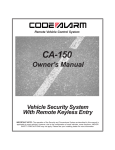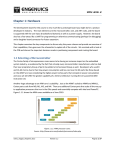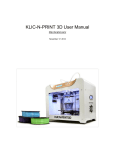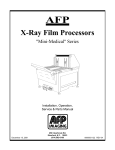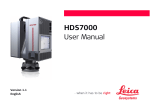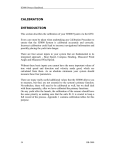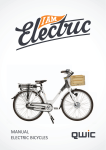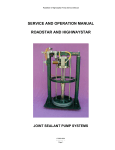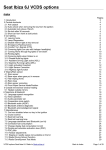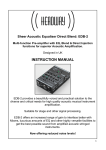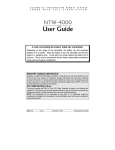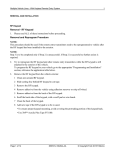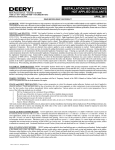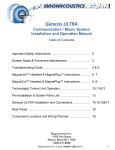Download Crack Sealer
Transcript
Ohio Department of Transportation Crack Sealer Office of Training: Equipment Training Section October 2006 Crack Sealer Table of Contents: Course Schedule.............................................................................................................................. ii Abstract .......................................................................................................................................... iii Learning Objectives ....................................................................................................................... iii Lesson One: Introduction................................................................................................................ 1 Lesson Two: Safety ...................................................................................................................... 17 Lesson Three: Pre-Trip Inspection................................................................................................ 29 Lesson Four: Crack Sealer Operation ........................................................................................... 47 Lesson Five: Transportation and Maintenance ............................................................................. 77 Lesson Six: Field Exercises .......................................................................................................... 87 Appendix A: Tailgate Safety Talk Appendix B: EM-78/HE Pre-Trip Inspection Form Appendix C: EM-44 Operator’s Report Appendix D: Program Activity Guideline 6124 Office of Training: Equipment Training Section i Crack Sealer October 2006 Course Schedule Day One Start Duration Title Abstract 8:30 a.m. 5 minutes Abstract and Learning Objectives Lesson One 8:35 a.m. 35 minutes Introduction Lesson Two 9:10 a.m. 35 minutes Safety Lesson Three 9:45 a.m. 15 minutes Pre-Trip Inspection Break 10:00 a.m. 15 minutes Lesson Three 10:15 a.m. 15 minutes Pre-Trip Inspection (cont’d) Lesson Four 10:30 a.m. 40 minutes Crack Sealer Operation Lesson Five 11:10 a.m. 20 minutes Transportation and Maintenance Lunch 11:30 a.m. 60 minutes Lesson Six 12:30 p.m. 90 minutes Field Exercises Break 2:00 p.m. 15 minutes Lesson Six 2:15 p.m. 60 minutes Field Exercises (cont’d) Wrap Up 3:15 p.m. 15 minutes Adjourn 3:30 p.m. ii Office of Training: Equipment Training Section Crack Seal October 2006 Abstract This course prepares participants to operate a crack sealer safely and effectively as a part of ODOT’s Preventative Maintenance Program. Participants will review various components of a crack sealer and various models utilized within the agency. The personal protective equipment necessary when crack sealing will be covered, in addition to operation of a crack sealer and types of crack sealing. A model rotation scheduled is covered, as well as clean up, transportation and maintenance of a crack sealing machine. Learning Objectives The learning objectives for this course are as follows: • Introduction to crack sealing equipment and understanding safety procedures • Personal Protective Equipment (PPE) to be used when crack sealing • How to conduct a pre-trip inspection • Coverage of proper heating procedures • How to fill, heat, circulate and apply material • Following proper clean up procedures • Proper transportation and maintenance of a crack sealer Office of Training: Equipment Training Section iii Crack Sealer October 2006 iv Office of Training: Equipment Training Section Lesson One Crack Sealer October 2006 Lesson One: Introduction LESSON ONE: Introduction Office of Training: Equipment Training Section 1 Crack Sealer October 2006 Lesson One A. What is Crack Sealing? What is Crack Sealing? A preventative maintenance activity placing specialized materials into existing cracks in the pavement Crack sealing accomplishes three things Minimizes pavement deterioration Slows pavement crack deterioration Minimizes water saturation into pavement sub-base 1. Crack sealing is the placement of specialized materials into existing cracks in the pavement 2. Crack sealing is a preventive maintenance activity designed to minimizes the amount of water in cracked pavement and provide reinforcement for adjacent pavement 3. Crack sealing accomplishes three goals a. Minimizes pavement deterioration b. Slows pavement crack deterioration c. Minimizes water saturation into pavement sub-base 2 4. This is a cost-effective way of extending pavement life and preparing the existing pavement prior to a hot mix asphalt overlay 5. Also delays the need for more costly cutting and filling or full depth repairs resulting in a cost savings 6. Cracks with significant crumbling of the crack face and secondary branch cracking need more than just a crack seal and should be considered for an alternative type of preventive maintenance application Office of Training: Equipment Training Section Lesson One Crack Sealer October 2006 B. Components and their Functions 15 27 29 30 12 25 14 6 31 23 8, 9 7 20 11 13 5 24 28 16 10 17 19 22 18 21 26 Figure 1-1 Crack sealer components 1. Tank outlet valve • 2. Access port • 3. The sealing wand is placed in here when not in use. This allows the operator to continue circulating material through the hose to prevent material from cooling and freezing up. Loading door • 4. Allows melted material from the tank to flow into the pumping section Place the material on the safety door to load the melting tank Oil temperature gauge • Monitors the heat transfer oil temperature Office of Training: Equipment Training Section 3 Crack Sealer October 2006 Lesson One 5. Material temperature gauge • 6. Pressure valve • 7. Opening this valve will allow the material being pumped to flow through the hose and sealing wand. The valve should be in the full "on" position during operation to prevent flow restriction. Agitation drive control knob • 9. This valve controls the flow rate of the material being pumped to the hose and sealing wand by changing the pressure setting. (Turning the valve clockwise will increase the pressure which in turn will increase the flow). During sealing operations, this valve alone can be used to regulate flow. Sealing hose valve • 8. Reads material temperature as it pumps through the plumbing system Rotate knob counterclockwise to start agitation. Rotate knob clockwise to reverse agitation, which is useful for dislodging material. Center position is neutral. Pressure gauge • This gauge measures the pressure required to turn the agitator. By observing this gauge, the operator can tell if the agitator is rotating. 10. Pump drive control knob • Rotate knob counterclockwise to start material pump for sealing operation. Rotate the knob clockwise to reverse the material flow. Reverse flow is used for system cleanout. Center position is neutral. 11. Air cleanout valve (optional) • Connect air line or solvent line to this connector to flush out system. This valve should remain closed at all times other than cleanout. 12. Temperature control box • This control allows the operator to set the desired oil and material temperatures. The setting will be maintained automatically. 13. Wand holder • 4 On models with the electrically heated hose, the wand is placed into this holder Office of Training: Equipment Training Section Lesson One Crack Sealer October 2006 14. Cabinet temperature gauge • Indicates the temperature inside the cabinet. Not to exceed 320º F. If conditions will cause this temperature to be exceeded, open cabinet door. 15. Thermal regulating gate • Lift lever to open gate and direct hot air to cabinet to heat pump and plumbing 16. PSI gauge • This gauge provides the amount of pressure in the hydraulic system 17. Ignition access door • On diesel models, lift this door for access to ignition key 18. Engine compartment a. Supplies power to hydraulic and heating systems b. Battery, hydraulic pump and air compressor are usually contained in this area 19. Frame • Supports components of the crack sealer 20. Hitch • An adjustable height ring allowing hookup to towing vehicle 21. Tongue jack • Supports the tongue when not hooked up to a towing vehicle 22. Wheel, brake and axle/suspension assembly • Supports crack sealer weight and assists in slowing/stopping 23. Fuel tank • Contains diesel to run engine and burner 24. Hydraulic tank • Contains hydraulic oil for hydraulic system Office of Training: Equipment Training Section 5 Crack Sealer October 2006 Lesson One 25. Heat transfer oil • Oil which transfers heat from the burner to the material tank 26. Material tank • Where crack sealing material is heated 27. Agitator motor and agitator • Hydraulic motor which turns the agitator in the material tank and paddle in material tank mixing crack sealing material and any additional materials 28. Material circulation pump a. A hydraulic motor operates the pump which circulates material in the material tank and to the hose and wand b. The pump can be run both forward and backwards 29. Hose boom • Holds the crack sealing hose/wand assembly. Can be free to rotate or be locked into position. 30. Hose a. The hose connects the circulation pump to the wand which permits crack sealing material to flow to the wand b. The hose may be heated or unheated 31. Wand a. The wand applies material to the cracks. It has an on and off valve to control flow of material and may have a shoe on its end to spread material. b. The wand may be heated or unheated 32. Items not pictured a. Heat lance • 6 Uses air and propane torch to dry, heat and blow out cracks. Can be attached to or separate from the crack sealer. Office of Training: Equipment Training Section Lesson One Crack Sealer October 2006 b. Squeegee i. Used to spread material on road ii. Usually made to prevent width of material from exceeding 4" c. Shoe i. Attaches to end of wand to spread material ii. Has several designs for different applications iii. Usually made to prevent width of material from exceeding 4" C. Crack Sealers Used by ODOT a. Equipped with or without an air compressor b. Crafco Figure 1-2 Crack sealer – Crafco Office of Training: Equipment Training Section 7 Crack Sealer October 2006 Lesson One c. Cim Line Figure1-3 Crack sealer – Cim Line d. Stepp Figure1-4 Crack sealer – Stepp e. Bearcat, Condor and Falcon crack sealers are also on inventory but are not used as frequently 8 Office of Training: Equipment Training Section Lesson One Crack Sealer October 2006 D. Types of Cracking 1. Block cracking Figure1-5 block cracking a. Found mainly on low volume roads and parking lots b. Without the traffic to keep the pavement flexible from use, it becomes brittle and breaks in block patterns 2. Reflection cracking Figure 1-6 reflection cracking Office of Training: Equipment Training Section 9 Crack Sealer October 2006 Lesson One a. Occurs primarily in resurfacing projects but can occur when the soil subgrade dries and shrinks • 3. Soil sub-grade is the soil below the base of the road Joint cracking a. Found along the joint where bond failure has occurred because of improper sealing, compaction or too much or too little overlap of the hot mix asphalt overlay (HMA) joint • The HMA is the top layer of surface or the top layer of the pavement Figure 1-7 joint cracking 10 Office of Training: Equipment Training Section Lesson One Crack Sealer October 2006 4. Slippage cracking Figure 1-8 slippage cracking a. Generally the result of a poor bond between the asphalt and the original pavement b. Construction factors causing a poor bond i. Too heavy or improperly cured prime or tack coat • The prime or tack coat is the liquid asphalt sprayed onto existing payment to ensure the new HMA bonds to the existing pavement surface ii. Too light a coat of liquid asphalt (tack coat) iii. Paving over dirty or wet pavement iv. Too much liquid asphalt on pavement surface c. Caused by soft sub-grade or traffic loads exceeding the design limit Office of Training: Equipment Training Section 11 Crack Sealer October 2006 Lesson One 5. Thermal cracks Figure 1-9 thermal cracking • 6. Develop when a pavement is constructed with too small a percentage of air voids to provide the pavement’s internal stress relief system Fatigue or alligator cracking Figure 1-10 alligator cracking a. Occurs when the asphalt loses flexibility b. As the asphalt ages and oxidizes from sun, rain, and air, it starts to become rigid and cracking results 12 Office of Training: Equipment Training Section Lesson One Crack Sealer October 2006 c. These cracks are seldom routed and sealed individually because the intensity of the crack patterns usually warrants an area treatment rather than individual crack treatment 7. Edge cracking Figure 1-11 edge cracking a. Generally parallel (within 18 inches) to the edge of the pavement b. Causes i. Poor base ii. Lack of shoulder support iii. Poor drainage iv. Freezing and thawing of the pavement surface (frost action) Office of Training: Equipment Training Section 13 Crack Sealer October 2006 Lesson One C. Products Used to Crack Seal Products Used to Crack Seal Liquid Block Fiber Rubber Gilsonite 1. Liquid a. Liquid asphalt is used for crack sealing by ODOT b. Normally delivered to ODOT facilities and stored in bulk storage tanks c. Can be picked up at a private bulk plant with a distributor truck d. Liquid asphalt weighs 8.25 pounds per gallon 2. Block a. Ready to use material shaped in blocks approximately one foot square and weighing 30 pounds b. The blocks are packaged in a cardboard box with instructions for their safe use printed on them • Remove cardboard box before placing the material in the crack sealer c. Many different asphalt products are prepackaged in block form d. Blocks are placed into the crack sealer and allowed to melt and mix with the material in the crack sealer before and during application 14 Office of Training: Equipment Training Section Lesson One Crack Sealer October 2006 e. There may be several different asphalt materials in block form being put into the crack sealer at the same time • Make sure the materials are compatible 3. Fiber a. Packaged in blocks and 10 pound bags i. Place fibers, bag and all, into the hot AC in the kettle • The fiber bags are designed to melt inside the crack sealer ii. Can be added until proper proportions are achieved iii. There are two types of fiber-polypropylene and polyester 4. Rubber a. Is usually ground-up tires, but can be made from other materials b. Packaged in 50 pound bags and 30 pound blocks c. Added to liquid asphalt to increase flexibility and the life of the crack sealing material 5. Gilsonite a. Gilsonite is a glossy black solid hydrocarbon resin visually similar to coal or hard asphalt b. ODOT uses Gilsonite mixed with MC-3000 and rubber to set up the mixture at higher temperatures • Helps reduce tracking c. Used only when crack sealing operations are performed in warmer temperatures (normally above 45 degrees) d. Packaged in 7 pound bags; mix one 7 pound bag per 50 pound bag of rubber e. The crack sealer should be emptied regularly to prevent build up of Gilsonite f. Build up may cause difficulty in getting material out of the crack sealer Office of Training: Equipment Training Section 15 Crack Sealer October 2006 Lesson One _______________________________________________________________________________ _______________________________________________________________________________ _______________________________________________________________________________ _______________________________________________________________________________ _______________________________________________________________________________ _______________________________________________________________________________ _______________________________________________________________________________ _______________________________________________________________________________ _______________________________________________________________________________ _______________________________________________________________________________ _______________________________________________________________________________ _______________________________________________________________________________ _______________________________________________________________________________ _______________________________________________________________________________ _______________________________________________________________________________ _______________________________________________________________________________ _______________________________________________________________________________ _______________________________________________________________________________ _______________________________________________________________________________ _______________________________________________________________________________ _______________________________________________________________________________ _______________________________________________________________________________ _______________________________________________________________________________ _______________________________________________________________________________ 16 Office of Training: Equipment Training Section Lesson Two Crack Sealer October 2006 Lesson Two: Safety LESSON TWO: Safety Office of Training: Equipment Training Section 17 Crack Sealer October 2006 Lesson Two A. Crack Sealing Accidents Crack Sealing Accidents Most crack sealing accidents result in burns from splattered hot material Use gloves to handle the wand and hose to prevent burns 1. Most crack sealing accidents result in burns from splattered hot material 2. Use gloves to handle the wand and hose to prevent burns a. Accident histories i. Crew did not circulate material during lunch a) Someone kept squeezing trigger to start sealing, but material did not flow b) A plug suddenly exploded out of the wand spraying liquid asphalt in all directions c) Employee received second and third degree burns over the face d) Emergency treatment was required at a hospital burn unit ii. Crew did not circulate material during lunch a) Employee started to apply material and a bubble formed at the tip b) When it popped, it splashed and hit the wand operator in the face 18 Office of Training: Equipment Training Section Lesson Two Crack Sealer October 2006 c) There were only a few spots, but the burns were severe iii. Wand became plugged and when it was unscrewed from the hose, the material sprayed out a) Employee’s arm was covered with hot material b) Went to hospital for treatment iv. For several hours the crack sealer was heated by an employee a) Another employee attempted to screw the shoe on the wand 1) Material shot out of the wand 2) Employee sustained first and second degree burns on face, head and neck v. Wand valve and circulation valve were left open a) Wand plugged up and when the plug released, it shot several feet 1) The wand operator did not have time to get the wand into the access port or shut off the wand valve 2) Luckily no one was injured vi. Wrong hose on wand a) There are different temperature ratings for crack sealing hoses b) Both high and low temperature hoses are in use in ODOT c) A low temperature hose was put on a high temperature crack sealer by mistake d) The hose broke down due to the high temperature at the hose-to-wand connection and sprayed the wand operator on the side of the face e) Employee sustained second and third degree burns on face and neck Office of Training: Equipment Training Section 19 Crack Sealer October 2006 Lesson Two vii. Tip of wand hitting pavement a) Causes material to splatter and hit the wand and squeegee operators b) Luckily the material hit the employee’s pants and no injuries resulted viii. Wand valve left open a) When removing wand from access port, wand valve was not closed, spraying hot material b) Fortunately no one was injured ix. Ignition of vapors a) Crew was having difficulty getting the heated wand to circulate b) Mechanics were working on wand and when it was put into the access port, a spark ignited vapors coming off the material c) There were no injuries in this case x. Transfer of liquid asphalt a) Multiple people were burned during a transfer of liquid asphalt from a distributor truck to the crack sealer when too much pressure on the hose caused those holding the hose to lose control b) Two of the crew members were treated for minor burns • 20 One of the burned employees had an allergic reaction to the material which required treatment from a doctor Office of Training: Equipment Training Section Lesson Two Crack Sealer October 2006 4. Safety Procedures Safety Procedures Have a tail gate safety talk before going out on the road Determine type of traffic control required Determine rotation of crew Review safety procedures Understand what Personal Protective Equipment (PPE) is to be worn depending on equipment used a. Have a tail gate safety talk (see Appendix A) b. Determine type of traffic control required c. Determine rotation of crew d. Review safety procedures e. Understand what Personal Protective Equipment (PPE) is to be worn depending on equipment used f. Be aware of what to do in case of injury / accident g. Know first aid procedures h. Remember to establish escape routes in case of an emergency i. Know the location of fire extinguishers i. Minimum ten pound type ABC rated or CO2 recommended a) An “A” rating is for trash, wood and paper b) A “B” rating is for liquids and grease c) A “C” rating is for electrical equipment Office of Training: Equipment Training Section 21 Crack Sealer October 2006 Lesson Two ii. Two or more are needed j. Establish backing procedures i. Use a spotter whenever possible ii. Ensure area behind crack sealer is clear k. Establish hand signals to be used l. Know the flash point and heating temperature of the crack sealing material i. Exceeding the flash point and heating temperature will increase the risk of ignition ii. It is important that all covers on the crack sealing machine be unlatched when at the job site or heating material • If the vapors ignite, the covers will blow open and release pressure m. Regularly check the temperature of the material in the crack sealer 5. Have Material Safety Data Sheets (MSDS) for material used on the job site Material Safety Data Sheets (MSDS) Have the most current MSDSs for the crack sealing material, heat transfer oil, and diesel fuel before starting the job Everyone on the crew needs to review the MSDS before starting job 22 Office of Training: Equipment Training Section Lesson Two Crack Sealer October 2006 a. This includes crack sealing material, heat transfer oil, and diesel fuel b. Everyone on the crew needs to review the MSDS before starting the job c. MSDSs change on a regular basis; ensure you have the most current B. First Aid First Aid Get immediate medical attention for any injury Types of injuries Inhalation Burns Skin contact Ingestion Eye contact 1. Get immediate medical attention for any injury 2. Inhalation • If affected, move person to fresh air 3. Burns a. Minor asphalt burns i. Injury to small areas ii. Involves a small quantity of asphalt b. Serious asphalt burns i. Injuries to head face or extremities ii. Involves large amounts of asphalt iii. Evidence of nausea or faintness Office of Training: Equipment Training Section 23 Crack Sealer October 2006 Lesson Two 4. Skin contact a. Cool molten asphalt and affected parts of the body immediately i. Completely submerge affected area in ice water ii. Use any available water (cooler than body temperature) while arranging for better cooling a) Keep five gallons of drinkable water near the crack sealer to cool down material burns b) Do not apply ice directly to an affected area iii. Do not attempt to remove cooled asphalt from an affected area iv. Do not attempt to remove the asphalt with products containing solvents or ammonia 6. Ingestion • Do not induce vomiting or provide anything to drink unless directed by a physician 7. Eye contact a. Direct contact with hot material will cause thermal burns and possible blindness b. For contact with hot molten material, vapors, or dust, hold eyelids apart and flush with large amounts of lukewarm water for at least 15 minutes • 24 Portable eye wash bottles shall be kept with the first aid kit for flushing, per district policy Office of Training: Equipment Training Section Lesson Two Crack Sealer October 2006 G. Material Safety Material Safety Safety procedures Wand placement when not in use Temperature settings Heated wands, if equipped Vent vapors Ignition sources Spills and leaks 1. Safety procedures a. Never look down the barrel of the wand; material may splatter in one’s face b. Never use open flames like a fuse or torch to unplug a hose or wand c. Never leave the crack sealer unattended d. Never overfill the crack sealer or material may spill out while driving or overflow while heating due to expansion e. Never mix non-compatible crack sealing materials f. Never heat crack sealing material above the recommended temperature g. Never transport the crack sealer with the burner on h. Always make certain the wand is turned off before removing from the access port and whenever repair work is to be performed on the wand Office of Training: Equipment Training Section 25 Crack Sealer October 2006 Lesson Two 2. Place the wand into the access port when not in use a. Permits circulation of material b. If any plugs develop, they will pop out into the crack sealer 3. Temperature settings a. Operators need to know the maximum temperature settings for the heat transfer oil and materials used in the crack sealer b. Exceeding the recommended temperatures can lead to material boil over or ignition c. There are several different types of heat transfer oil i. Consult the operator’s manual to determine what type of heat transfer oil is in the crack sealer and its maximum safe operating temperature ii. Maximum temperature is usually set at the factory iii. If heat transfer oil temperature is not set then consult the operator’s manual to determine maximum heat transfer oil temperature d. Material temperatures depend on the type of crack sealing material • Check with your supervisor when using liquid asphalt e. If material is in blocks, the boxes should provide heating instructions 4. Heated wand (if equipped) a. Some heated wands have either on or off settings - the temperature of the wand cannot be set b. Some heated wands have a thermometer control to set the temperature to the recommended material temperature c. Read the material instructions to determine the proper temperature setting 5. Vent vapors a. This prevents ignition b. Provide only one vent (access port) to control the air supply necessary to support combustion 26 Office of Training: Equipment Training Section Lesson Two Crack Sealer October 2006 6. Ignition sources a. Keep all sources of ignition away from hot crack sealing materials i. Electric sparks ii. Open flames iii. Cutting torches iv. Smoking materials 7. Spills and leaks a. Asphalt leaks should be stopped as soon as possible i. Provides fuel if an ignition source is present ii. Presents the potential for burn injuries b. Spills should be contained by i. Digging a hole and allowing spilled material to sit inside ii. Impounding spilled material by surrounding with dirt or available material iii. Placing a container under the spill c. Spills that do not solidify upon cooling may require the use of an absorbent material such as sand, dirt or sawdust Office of Training: Equipment Training Section 27 Crack Sealer October 2006 Lesson Two _______________________________________________________________________________ _______________________________________________________________________________ _______________________________________________________________________________ _______________________________________________________________________________ _______________________________________________________________________________ _______________________________________________________________________________ _______________________________________________________________________________ _______________________________________________________________________________ _______________________________________________________________________________ _______________________________________________________________________________ _______________________________________________________________________________ _______________________________________________________________________________ _______________________________________________________________________________ _______________________________________________________________________________ _______________________________________________________________________________ _______________________________________________________________________________ _______________________________________________________________________________ _______________________________________________________________________________ _______________________________________________________________________________ _______________________________________________________________________________ _______________________________________________________________________________ _______________________________________________________________________________ _______________________________________________________________________________ _______________________________________________________________________________ 28 Office of Training: Equipment Training Section Lesson Three Crack Sealer October 2006 Lesson Three: Pre-Trip Inspection LESSON THREE: Pre-Trip Inspection Office of Training: Equipment Training Section 29 Crack Sealer October 2006 Lesson Three A. Overview 1. The pre-trip inspection is vital to the life and the operation of the crack sealer 2. Conduct daily or at the beginning of a shift change 3. Pre-trip inspections reduce down time, equipment cost, equipment hazards, and personal injury B. Operator Requirements Operator Requirements Eye sight Mobility Hearing Physical condition Mental alertness Experience Awareness Additional requirements 1. Good eyesight • Depth perception, distance and peripheral vision are all required for proper operator performance 2. Mobility • Able to lift and move the wand 3. Hearing • 30 Able to detect and identify unusual noises Office of Training: Equipment Training Section Lesson Three Crack Sealer October 2006 4. Overall physical condition a. Medical conditions to consider i. Any physical limitation which could affect the ability of the operator to operate efficiently and safely, such as back problems ii. Medication side effects 5. Mental alertness a. Potential obstacles i. Personal problems ii. Attention deficit iii. Stress iv. Lack of sleep 6. Experience • Operator experience must be considered, but inexperience can be overcome by formal or on-the-job training 7. Awareness a. Operators need to be aware of hazards associated with i. Equipment ii. Themselves iii. Their crew iv. The public 8. Additional requirements a. Ability to read and understand placards, the operator’s manual, safety codes and other information relating to correct, safe crack sealer operations b. Knowledge of how to implement all emergency procedures c. Familiarization with all relevant safety standard codes and applicable government regulations Office of Training: Equipment Training Section 31 Crack Sealer October 2006 Lesson Three d. Thorough familiarity with the crack sealer being operated and its control functions including operating procedures as outlined by the manufacturer e. Ability to recognize and be responsible for all maintenance requirements of the crack sealer C. Personal Protective Equipment (PPE) Personal Protective Equipment (PPE) Clothing Footwear Eye Protection Gloves Hearing protection Safety vest 1. Clothing a. Should not be bulky because bulky clothing restricts movement b. Should be fitted • Loose fitting clothing can snag controls or get caught when entering or exiting equipment c. Dress in layers and add or remove layers as needed d. Do not wear i. Jewelry ii. Any item which could become snagged and cause damage or injury e. Clothes made of synthetic fibers (polyester, plastic, etc.) can melt and adhere to the skin when heated 32 Office of Training: Equipment Training Section Lesson Three Crack Sealer October 2006 f. Shirt should have long sleeves rolled down and cuffs buttoned or similar upper body covering to protect from spilled crack sealing material g. Pants should be long with no cuffs and cover the top of shoes or boots for protection from spilled crack sealing material • Coveralls or heat aprons can also be worn for protection 2. Footwear • A leather boot with ankle protection is recommended 3. Eye protection a. Safety glasses are highly recommended and may be required by your district i. Make sure they are clean, fitting properly, and are safety rated ANSI Z87.1 ii. Over the counter sun glasses are not considered proper eye protection unless they have the ANSI Z87.1 stamp on them b. Face shields should be worn when operating the crack sealer and air compressor c. Contacts should not be worn without proper eye protection 4. Gloves a. May be needed depending on i. Weather ii. Site conditions iii. Operator preference b. Should fit snugly enough to allow the operator to feel the controls 5. Hearing protection • May be required, depending on the equipment; check with your Safety Office 6. Safety vests • Safety vests should be worn at all times unless supervision deems it to be hazardous Office of Training: Equipment Training Section 33 Crack Sealer October 2006 Lesson Three D. Additional Required Equipment Additional Required Equipment Drinking water Five gallon bucket of water for burns MSDS 1. Drinking water • It is important to keep hydrated while working in hot weather and/or with hot materials 2. Five gallons of drinkable water • Five gallons must be available to pour on or submerge the burns in the event of crack sealing material coming into contact with the skin 3. Have MSDS for the material being used on the job site a. This includes crack sealing material, heat transfer oil, and diesel fuel b. Everyone on the crew needs to review the MSDS before starting the job 34 Office of Training: Equipment Training Section Lesson Three Crack Sealer October 2006 E. Proper Pre-Trip Inspection for Crack Sealer (see Appendix B for the EM-78/HE) Proper Pre-Trip Inspection for the Crack Sealer Engine compartment Heat transfer oil Hoses Air compressor 1. Engine compartment a. Heat transfer oil • Make sure the oil level is above the add lines in the site glass Office of Training: Equipment Training Section 35 Crack Sealer October 2006 Lesson Three b. Hoses Figure 3-1 i. Check the hoses circulating coolant to and from the engine and radiator ii. Check the hydraulic hoses with a clipboard or other solid object for any cracks or pin holes a) Never use bare hands to check hydraulic lines b) Hydraulic systems are pressurized, and can cause serious injury if fluid is injected into the skin c. Air compressor (if equipped) i. Check the oil level to make sure it is at the proper level ii. Ensure the air compressor is firmly secured to the crack sealer iii. Open the drain valve at the bottom of the air tank and allow all water accumulated to drain, if so equipped iv. Check all air lines and connections for cuts or leaks 36 Office of Training: Equipment Training Section Lesson Three Crack Sealer October 2006 2. Start-up Proper Pre-Trip Inspection for the Crack Sealer (cont’d) Start-up Lighting indicators Bypass button Burner ignition Wand heater a. Lighting indicators i. Check all lighting indicators upon turning on the ignition ii. Glow plug iii. Bypass button b. Allow engine to warm up for at least five minutes before starting the hydraulic and heating systems Office of Training: Equipment Training Section 37 Crack Sealer October 2006 Lesson Three c. Burner ignition Figure 3-2 i. Turn on master switch ii. Set temperature for transverse oil (heating oil) at approximately 120 degrees iii. Set temperature for material at approximately 120 degrees a) Allow to cycle several times to ensure heating system is functional b) If using blocks, set temperatures per the instructions on the box and proceed to fill with blocks c) If this is the first time the crack sealer is being run for the season, set heat transfer oil to not more than 225 degrees for two hours to boil moisture out of the heat transfer oil iv. Ensure draft cover(s) are open d. Wand heater • Turn on wand to see if the electric element works 3. If any problems are found, fill out an EM-44 Operator’s Report form to have it repaired (see Appendix C) 38 Office of Training: Equipment Training Section Lesson Three Crack Sealer October 2006 3. Walk around inspection Proper Pre-Trip Inspection for Crack Sealer (cont’d) Walk around inspection General Attachments a. General i. Covers, shrouds and guards a) Ensure all moving parts are covered 1) Hydraulic motors 2) Belts 3) Engine compartment b) Confirm bolts are tight and pins are in place Office of Training: Equipment Training Section 39 Crack Sealer October 2006 Lesson Three ii. Decals Figure 3-3 • Present and readable iii. Cleanliness of crack sealer • Remove any spilled material iv. Loading doors Figure 3-4 a) Hinges b) Lays flat c) Lubricated d) Shelf for block in good shape v. Make sure valves are closed 40 Office of Training: Equipment Training Section Lesson Three Crack Sealer October 2006 vi. Have controls in the neutral position vii. Crack sealing material a) Check level of material b) Check type of material 1) Need to ensure any material in the crack sealer is compatible with the material being added 2) Some materials are not compatible and caution must be exercised b. Attachments i. Hitch Figure 3-5 a) Secured to crack sealer with locking pin in place b) Correct height to keep crack sealer level • Office of Training: Equipment Training Section Some hitches can be adjusted by removing the mounting bolts and raising and lowering the hitch 41 Crack Sealer October 2006 Lesson Three Figure 3-6 c) Check landing gear/support jack to see if it is secured to the crack sealer and in good operating condition d) Not worn beyond tolerances ii. Safety chains a) Secured to crack sealer b) Hooks must be functional 1) Not cracked 2) Safety clips must be functional 3) If hooks are attached to the towing vehicle, ensure the towing vehicle hitch is secured with the locking pin in place, so the hitch will not open 42 Office of Training: Equipment Training Section Lesson Three Crack Sealer October 2006 iii. Wand / hose Figure 3-7 a) Valve functions b) No leaks c) Hose not worn through d) Hose free of kinks e) Hose protection in place f) Heating elements are working (if equipped) g) Clean h) Hose clamps must be tight iv. Access port • Must be unobstructed to allow insertion of wand to permit circulation of material v. Hose boom a) Swivels freely when wand / hose is attached to it b) Straight and not damaged Office of Training: Equipment Training Section 43 Crack Sealer October 2006 Lesson Three vi. Shoe Figure 3-8 a) Attached to wand • Proper size for job b) Clean i. If clogged, the application of new material will be inconsistent and will not effectively treat the surface ii. Clean only with materials approved by your district and ensure waste from clean up is properly disposed 44 Office of Training: Equipment Training Section Lesson Three Crack Sealer October 2006 _______________________________________________________________________________ _______________________________________________________________________________ _______________________________________________________________________________ _______________________________________________________________________________ _______________________________________________________________________________ _______________________________________________________________________________ _______________________________________________________________________________ _______________________________________________________________________________ _______________________________________________________________________________ _______________________________________________________________________________ _______________________________________________________________________________ _______________________________________________________________________________ _______________________________________________________________________________ _______________________________________________________________________________ _______________________________________________________________________________ _______________________________________________________________________________ _______________________________________________________________________________ _______________________________________________________________________________ _______________________________________________________________________________ _______________________________________________________________________________ _______________________________________________________________________________ _______________________________________________________________________________ _______________________________________________________________________________ _______________________________________________________________________________ Office of Training: Equipment Training Section 45 Crack Sealer October 2006 Lesson Three _______________________________________________________________________________ _______________________________________________________________________________ _______________________________________________________________________________ _______________________________________________________________________________ _______________________________________________________________________________ _______________________________________________________________________________ _______________________________________________________________________________ _______________________________________________________________________________ _______________________________________________________________________________ _______________________________________________________________________________ _______________________________________________________________________________ _______________________________________________________________________________ _______________________________________________________________________________ _______________________________________________________________________________ _______________________________________________________________________________ _______________________________________________________________________________ _______________________________________________________________________________ _______________________________________________________________________________ _______________________________________________________________________________ _______________________________________________________________________________ _______________________________________________________________________________ _______________________________________________________________________________ _______________________________________________________________________________ _______________________________________________________________________________ 46 Office of Training: Equipment Training Section Lesson Four Crack Sealer October 2006 Lesson Four: Crack Sealer Operation LESSON FOUR: Crack Sealer Operation Office of Training: Equipment Training Section 47 Crack Sealer October 2006 Lesson Four A. Filling with Material Filling with Material Bulk storage Distributor truck Using blocks 1. Filling from bulk storage (ODOT or private) a. Shut down crack sealer before filling • No open flame near material storage b. Need two people to fill crack sealer i. One person on crack sealer to measure material ii. One person to open/control valve from bulk tank c. Measure level of material i. Private bulk plants determine material sold by weight a) Weigh whole unit before filling to determine how much material to load b) Operator’s manual identifies the units used to mark the measuring stick 48 Office of Training: Equipment Training Section Lesson Four Crack Sealer October 2006 ii. Stick measure from top of crack sealer to top of material a) The height of the stick measurement can be converted into a gallon amount b) This conversion varies with each crack sealer model • Refer to the operators manual for the conversion table Figure 4-1 c) Measure before filling 1) Know what is in the crack sealer 2) Do not mix non-compatible materials d) Measure while filling 1) Allow for expansion 2) Allow for other materials to be added 3) Ensure material will not splash out during transportation Office of Training: Equipment Training Section 49 Crack Sealer October 2006 Lesson Four e) Measure when finished filling • Know what amount of rubber or other material to add f) Measure at end of day • To determine amount to record on daily work report d. Pull crack sealer under bulk tank (ODOT or private) i. Ensure the crack sealer is centered under pour spout ii. Use extension on pour spout (if applicable) iii. Open cover to fill crack sealer a) Swing pour spout over open cover b) Person on bulk tank opens (unlocks) valve c) Person on crack sealer measures/watches crack sealer fill d) Person on crack sealer determines when to stop filling e) Person on bulk tank closes (locks) valve f) Remove extension (if used) g) Hang bucket on pour spout to prevent dripping/spillage h) Swing pour spout clear of crack sealer and secure i) Pull crack sealer away from bulk tank j) Weigh whole unit if at private bulk plant 2. Filling from distributor truck a. Pre-trip distributor truck b. Heat liquid asphalt to recommended temperature c. Pump over to crack sealer 50 Office of Training: Equipment Training Section Lesson Four Crack Sealer October 2006 3. Filling using blocks a. Remove the cardboard box containing the block • Ensure no cardboard gets into the material tank b. Stop the agitator to prevent splashing c. Open the material door and place block on the door against the holder d. Close door, dropping block into material tank i. Do not drop blocks into material tank with door open • Injury to operator can occur from splashed material e. Add blocks as the previous block melts up to desired level f. Heating i. Heat in a well ventilated area ii. After filling, start crack sealer a) Set temperature for heat transfer oil at recommended temperature 1) Normally 100 degrees above material temperature requirements 2) May need to adjust temperature (down to within 50 degrees of pour temperature) when material is at pouring temperature b) Set temperature for product 1) Supervisor will have temperature settings for bulk liquid 2) Read instructions on the box for the blocks g. Mixing of additional materials i. When the agitator moves freely, mix additional materials a) Adjust speed of the agitator as necessary b) Rubber 1) One bag per 50 gallons of product Office of Training: Equipment Training Section 51 Crack Sealer October 2006 Lesson Four 2) May need to break up rubber as it tends to clump together c) Gilsonite • One 7-pound bag per 50 pounds of rubber d) Fiber 1) Content should be 5-7% of the material’s weight (a) 10 pounds of fiber per 25 gal of material is 5% (b) 12.5 pounds per 25 gallons is 6% (c) 14 pounds per 25 gallons is 7% h. Circulation i. Through pump a) When product is hot enough for pump to circulate b) Open valve c) Turn on pump d) Adjust pump speed as necessary ii. Through wand a) Without heating element 1) When all material is thoroughly mixed and pump has circulated and material is hot 2) Remove wand from storage 3) Try to leave hose inside of heater/storage box 4) Place wand (and shoe if so equipped) into access port in tank 5) Open wand valve 6) Open valve to hose 7) Adjust pressure to hose 52 Office of Training: Equipment Training Section Lesson Four Crack Sealer October 2006 b) With heating element 1) Needs 30 minutes to heat up 2) Material must be in hose and wand to heat 3) Do not bend, move or kink hose when cold (a) Will lessen element service life (b) Could break the element 4) To prevent the liquid asphalt from sticking or bonding with the heating element, do not leave heat on more than 30 minutes without running material through wand • This process is sometimes referred to as coking 5) Turn on heating element 6) Place wand (and shoe if so equipped) into access port in tank 7) When wand is hot enough to permit circulation (a) Open wand valve (b) Open valve to hose (c) Adjust pressure to hose 8) Shut off heating elements once wand circulates (a) Turning off heating element will extend the heating element’s life (b) Operating conditions and some materials may require the heating element to be left on in order to prevent plugging Office of Training: Equipment Training Section 53 Crack Sealer October 2006 Lesson Four B. Covering Pavement Markings Covering Pavement Markings Do not cover pavement markings with crack sealing material unless necessary Covering pavement markings increases risk of accidents Traveling public cannot see edge of roadway Traveling public cannot see lane lines 1. Do not cover pavement markings with crack sealing material unless necessary Figure 4-2 a. This includes raised pavement markers (RPM) also known as life lights b. Supervisors should instruct crews on county procedures concerning cover-up of pavement markings and RPMs 54 Office of Training: Equipment Training Section Lesson Four Crack Sealer October 2006 c. Covering pavement markings increases the risk of accidents i. Traveling public cannot see edge of roadway ii. Traveling public cannot see lane lines d. Pavement markings are part of the Organizational Performance Index (OPI) measurement i. "Pavement edge line or center line or both in excess of 150 linear feet that is significantly faded, missing, or covered by anything excluding snow and ice. One deficiency will be recorded every 528 linear feet (1/10 mile) of edge line or center line or both." ii. "Pavement lane line in excess of 150 linear feet that is significantly faded, missing, or covered by anything excluding snow and ice. One deficiency will be recorded every 528 linear feet (1/10 mile) of highway lane." iii. "If a pavement edge line in excess of 150 linear feet is missing due to a recent paving operation, and ‘No Pavement Edge Line’ warning signs are posted every two miles, no deficiency will be recorded." e. If pavement markings are covered up i. Notify supervisor • Supervisor will have “NO EDGE LINES” signs posted until pavement markings are replaced f. Cover as little of the pavement markings as possible i. Wand operator should apply material along edge of pavement marking a) If wand has a shoe then use the shoe to control application of material along edge of pavement marking b) Also can use squeegees to control application of material along edge of pavement marking Office of Training: Equipment Training Section 55 Crack Sealer October 2006 Lesson Four C. Excessive Crack Sealing Excessive Crack Sealing Care should be exercised when crack sealing to ensure excessive amounts of material are not applied to the pavement Consideration should be given to either strip seal or chip seal when excessive amounts of material will be used to crack seal 1. Care should be exercised when crack sealing to ensure excessive amounts of material are not applied to the pavement a. Excessive amounts of material can lead to slippery conditions for traffic b. Crack sealing material may have to be covered with grits (#9) to prevent slippery conditions if wider than 4 inches or excessive amounts are used Figure 4-3 56 Office of Training: Equipment Training Section Lesson Four Crack Sealer October 2006 2. Consideration should be given to either strip seal or chip seal when excessive amounts of material will be used to crack seal • Supervisors should be notified in a situation where too much crack sealing material is being applied D. Work Zone Set Up Work Zone Set Up Signs Flaggers Recommended crew operations Breaks and lunches 1. Signs • As per Ohio Manual of Uniform Traffic Control Devices (OMUTCD) 2. Flaggers 3. Recommended crew operations a. Without blocks – two teams of three i. Two flagging and one driving ii. One operating the wand and two operating squeegees b. With blocks – two teams of three i. Two flagging, one driving ii. One operating the wand, one loading blocks and one directing the driver Office of Training: Equipment Training Section 57 Crack Sealer October 2006 Lesson Four 4. Recommended crew rotations a. Establish 10 minute rotations b. Switch teams every 30 minutes i. Spread the work load among all employees ii. Some wands are heavy and rotating every ten minutes reduces the strain on workers • Can use weed eater straps to put weight of wand on shoulder iii. Breaks can be non-continuous or a continuous switching of people approach can be used c. Non-continuous switching without blocks i. Driver honks horn every ten minutes to rotate ii. Flaggers and driver do not move until after third horn a) First horn - squeegee person switches with the wand operator b) Second horn - remaining squeegee person switches with wand operator c) Third horn - driver stops vehicle and flaggers and driver switch with people on crack sealer iii. Example of non-continuous switching without blocks Rotation Start First Horn Second Horn Third Horn (30 min.) 58 Employee #1 Squeegee Squeegee Wand Operator Teams switch Employee #2 Squeegee Wand Operator Squeegee Teams switch Employee #3 Wand Operator Squeegee Squeegee Teams switch Office of Training: Equipment Training Section Lesson Four Crack Sealer October 2006 d. Non-continuous switching if using blocks i. Driver honks horn every ten minutes to rotate ii. Flaggers and driver do not move until after third horn a) First horn - wand operator switches with either block loader or employee directing driver b) Second horn - wand operator switches with remaining person c) Third horn - flaggers and driver switch with people on crack sealer iii. Example of non-continuous switching with blocks Rotation Employee #1 Block Loader Driver Director Wand Operator Teams switch Start First Horn Second Horn Third Horn (30 min.) Employee #2 Driver Director Wand Operator Block Loader Teams switch Employee #3 Wand Operator Block Loader Driver Director Teams switch e. Continuous switching without blocks i. First two rotations are the same as non-continuous with blocks with only two squeegee operators and wand operator moving ii. Third horn comes at 25 minutes instead of 30 minutes a) Speeds up the process of switching the people on the crack sealer with flaggers and driver iii. At third horn (25 minutes) a) First squeegee operator replaces flagger in rear b) Flagger in rear replaces second squeegee operator c) Second squeegee operator replaces the front flagger d) Front flagger replaces the wand operator e) Wand operator replaces the driver f) Driver replaces first squeegee operator • Office of Training: Equipment Training Section Whole third rotation takes about five minutes 59 Crack Sealer October 2006 Lesson Four g) Start a new 30 minute rotation iv. Example of continuous switching without blocks Rotation Employee #1 Employee #2 Wand Operator Employee #3 Start Squeegee First Horn Wand Operator Squeegee Squeegee Second Horn Squeegee Squeegee Wand Operator Third horn (25 min.) Rear Flagger Front Flagger Driver Squeegee Employee #4 Front Flagger Front Flagger Front Flagger Wand Operator Employee #5 Rear Flagger Rear Flagger Rear Flagger Employee #6 Squeegee Squeegee Driver Driver Driver f. Continuous switching of crew with blocks i. First two rotations are the same as non-continuous with blocks with only block loader, wand operator and driver director moving • ii. Speeds up the process of switching the people on the crack sealer with flaggers and driver At third horn (25 minutes) a) Driver director replaces rear flagger b) Rear flagger replaces block loader c) Block loader replaces front flagger d) Front flagger replaces wand operator e) Wand operator replaces the driver f) Driver replaces driver director • Whole rotation should take about five minutes g) Start another 25-minute rotation 60 Office of Training: Equipment Training Section Lesson Four Crack Sealer October 2006 iii. Example of continuous switching with blocks Rotation Start First Horn Second Horn Third horn (25 min.) Employee #1 Block Loader Driver Director Wand Operator Driver Employee #2 Driver Director Wand Operator Block Loader Front Flagger Employee Employee Employee #3 #4 #5 Wand Front Rear Operator Flagger Flagger Block Front Rear Loader Flagger Flagger Driver Front Rear Director Flagger Flagger Rear Wand Block Flagger Operator Loader Employee #6 Driver Driver Driver Driver Director 5. Breaks and lunch a. Put wand into access port and circulate product i. Open wand valve to full and turn up flow through wand • Use bungee cord to secure wand into the access port b. Continue heating material to maintain pouring temperature if someone stays with the crack sealer E. Crack Seal Application Crack Seal Application ODOT’s Pavement Management System (PMS) identifies pavements on the statewide network which are candidates for crack sealing The optimal time to perform crack sealing is in cold weather Agency specifications require roads be maintained to a specified standard Office of Training: Equipment Training Section 61 Crack Sealer October 2006 Lesson Four 1. ODOT’s Pavement Management System (PMS) identifies pavements on the statewide network which are candidates for crack sealing a. The data used to identify potential pavements to be sealed are based on the Pavement Condition Rating (PCR) b. Crack sealing is performed at least one time between pavement resurfacing (sometimes two or three times) c. Approximately every three to five years is optimal d. Crack sealing should be performed 6-12 months prior to a hot mix asphalt (HMA) overlay 2. The optimal time to perform crack sealing is in cold weather • When the cracks are the widest because the pavement shrinks and cracks are open 3. Agency specifications require roads be maintained to a specified standard a. Cracks must be ¾ of an inch or less to fill b. Cracks larger than ¾ of an inch must be cut out per highway maintenance guidelines and then patched c. No greater than a 4 inch swath may be used when filling a crack d. Swaths greater than 4 inches may cause a slippery patch in the road creating hazards for cars or motorcycles 62 Office of Training: Equipment Training Section Lesson Four Crack Sealer October 2006 Crack Seal Application (cont’d) Road conditions Preparing pavement Filling crack Material setup Tracking 4. Road Conditions a. Work zone must be dry to apply product • Material will not stick to wet/damp pavement Figure 4-4 Example of liquid asphalt applied to a damp road Office of Training: Equipment Training Section 63 Crack Sealer October 2006 Lesson Four b. According to ODOT’s Construction and Material Specifications section 423 • “Do not seal the surface if it is visibly damp or the temperature is below 45 degrees F” c. If crack sealing material is applied when the temperature is close to 45 degrees, be sure cracks are dry and free from ice and other contaminants 5. Preparing pavement for application a. Blow out cracks (if applicable) i. For best performance of crack sealing material, cracks or joints should be cleaned to ensure bonding surfaces are free from all dust, moisture or other contaminates ii. Hot air lance a) Used to blow out cracks before sealing b) Uses heated compressed air to warm and dry the crack 1) Can raise temperature of crack above 45 degrees to permit crack sealing 2) Will permit crack sealing within 24 hours after rain c) Speed of air applied along the crack is critical 1) Too fast and the crack will not be dried or warmed 2) Too slow and the asphalt surface will be damaged iii. Air compressor • Used to blow out cracks before sealing iv. The crack sealing operation must be within 250 feet of the cleaning operation 6. Filling crack with material a. To reduce pick up by a vehicle’s tires or damage due to snow plow abrasion, crack sealing material height should not exceed 1/8 inch above the pavement surface b. Keep wand over crack 64 Office of Training: Equipment Training Section Lesson Four Crack Sealer October 2006 Figure 4-5 c. Ensure flow of material is not excessive • Excessive flow causes material waste and causes puddles d. Ensure crack is filled • May have to reapply e. Wand may be equipped with a shoe i. Type of shoes a) Square box Figure 4-6 Office of Training: Equipment Training Section 65 Crack Sealer October 2006 Lesson Four b) Circular Figure 4-7 ii. Ensure proper flow of material into the shoe iii. Excessive material will build up on roadway a) Spill over shoe 1) Not squeegeed 2) Exceeds 4 inch width iv. Not enough material a) Crack not sealed b) Shoe will drag and stick to pavement 66 Office of Training: Equipment Training Section Lesson Four Crack Sealer October 2006 f. Squeegee material Figure 4-8 i. Begin as soon as material is applied before it sets up ii. Rides on material iii. Not more than 4 inches wide 7. Material setup a. Allow material to setup before permitting traffic back on the pavement i. Let it cool to 140 degrees Fahrenheit or pavement temperature whichever is greater ii. Use handheld infrared temperature gauge b. To test for setup, press your work boot into material • When tread imprint is no longer seen in material (and material does not stick to boot), traffic can drive over it 8. Tracking a. Material will track if not allowed to set up b. Apply lime powder, Portland cement, or other covering if the liquid asphalt will not have time to set up before it is exposed to traffic i. 25 to 50 pound bags Office of Training: Equipment Training Section 67 Crack Sealer October 2006 Lesson Four ii. Can use shuttered lawn spreader to apply lime 4 to 6 inches wide • The shutter narrows the spreaders release to 4 to 6 inches so that the amount of material released is controlled c. Sand or grits (size #9) i. Come from quarry ii. Apply by hand using hand, shovel or spreader F. Recommended Crew Operating Process Recommended Crew Operating Process Heat tar prior to work crew arrival Unplug wand Availability of a second material hose Unplugging unheated wand Driver Squeegee 1. Have two people heat liquid asphalt prior to work crew arrival a. Not less than two and a half hours before crew reports b. Perform pre-trip inspection on crack sealer and vehicle pulling crack sealer c. Fill crack sealer with material and heat material d. Heat until agitator moves freely e. Add any additional material (rubber) f. Circulate material when pump turns freely g. When all materials are mixed in, circulate through wand 68 Office of Training: Equipment Training Section Lesson Four Crack Sealer October 2006 h. Turn crack sealer over to crack sealing crew • Crack sealer is left running, circulating material, but heating is shut down for trip to job site i. Crew preparation involves heating material to pouring temperature and setting up workspace i. Crew should be ready to pour when start point is reached ii. Flaggers are to be in position to flag when crew arrives j. When crack sealer arrives at the job, attach the wand to the hose boom and begin to squeegee using rotation k. At shut down, have flagger pick up work zone while shutting down crack sealer (off road at this time) • Have workers shut down crack sealer, so crew leader can start paperwork 2. Unplugging a heated plug wand a. Do not use a fuse or torch when unplugging the wand/hose • If the wand is plugged and the crack sealer has a heating box which the wand and hose are stored in, place wand and hose in box b. Turn up heating controls i. Do not exceed operating temperatures for material, heat transfer oil, and the storage cabinet • ii. Check with supervisor and read containers for specifications If burner does not ignite due to high material temperature, open up covers and allow material to cool down c. Allow material to liquefy in hose and wand d. Take wand out and put it in the access port and try to circulate e. If it is still plugged, repeat above steps 3. Have second material hose available to switch with plugged hose • Switch hoses at beginning of next day’s crack sealing to allow material to melt in hose during initial heat-up Office of Training: Equipment Training Section 69 Crack Sealer October 2006 Lesson Four 4. Unplugging an unheated plugged wand a. This procedure can also be used for hoses and wands with failed heating elements needing to be repair i. Take crack sealer back to garage ii. Take hose and wand off crack sealer and hang them up iii. Can use large ladder with pipe through rungs holding hose and wand iv. Make adapter to screw on end of hose with an air hose adapter a) Use an adapter which will thread onto crack sealing hose b) Use another adapter which will thread onto an air hose quick connect and the crack sealing hose adapter described above • These parts can usually be found in your garage Figure 4-9 Air hose quick connect to crack sealing hose adapter v. Place bucket under wand • Make sure the wand valve is open vi. Take a large torpedo heater from the garage and aim at hose/wand vii. Put air line on adapter viii. Turn on heater and stand away from set up 70 Office of Training: Equipment Training Section Lesson Four Crack Sealer October 2006 • There is a risk of liquid asphalt splatter when plugged hose/wand opens up ix. Air will push through plug • x. Usually a loud pop and rush of air occurs when the hose unplugs Close air valve and allow to rest for few minutes xi. Open air valve and let run until the hose and wand are clear xii. Put hose and wand back on crack sealer and circulate material through hose and wand to get remaining material melted out a) Clean wand/hose out b) Keep wand in crack sealer or store it xiii. Return items and clean up area xiv. Go back out and resume crack sealing operation 5. Driver a. Keep to right of roadway, enabling observation of the crew b. Establish hand signals with crew members to know when to stop, go forward, go faster, go slower • Squeegee operator should be signal person, so wand operator can keep pouring 6. Squeegee a. Using squeegee normally used as a water squeegee i. Remove rubber from squeegee and replace with strip cut from a mud flap a) The mud flap can be obtained from an flap ripped off a truck b) Longer service life is achieved using mud flap material than original rubber Office of Training: Equipment Training Section 71 Crack Sealer October 2006 Lesson Four G. Crack Sealer Shut Down Process Crack Sealer Shut Down Process Crew wrap-up Material life General guidelines Fill out form 502 1. Crew wrap-up a. Get crew off the road b. Pick up signs c. Shut down crack sealer d. Determine if material needs to be removed from the crack sealer 2. Material life a. Read instructions for material being used to know its service life b. Some materials can only be heated once or twice i. Additional heating may result in breakdown of properties a) Material will thicken, become “stringy” and may even gel b) Material needs to be immediately removed from the crack sealer and discarded 1) Use appropriate disposal procedures for material • 72 Refer to manufacturer’s instructions Office of Training: Equipment Training Section Lesson Four Crack Sealer October 2006 2) Use recommended clean out solvent per district policy and properly dispose of clean up waste 3. General guidelines for cleaning out wand, hose and circulation system a. There are several different crack sealers in use at ODOT i. Refer to operator’s manual for specific details ii. It is very important to clear the hose, wand and circulation system of material a) Reduces risk of wand/hose plugging b) Reduced time to start circulating hot material c) Some crack sealers may permit introduction of diesel/cleaning solvent to assist in cleaning out the system • Use proper disposal procedures per district environmental and safety policies b. Non-heated hose/wand i. Reverse pump to reverse flow of material from wand/hose to tank • ii. After several minutes, close hose and wand valve Allow material to flow back to tank from circulation system a) Shut valve to pump b) Shut off pump c. Heated hose/wand i. Do not clean out hose/wand of material a) Shut off heating element b) Close valve to hose c) Close valve to wand d) Reverse pump to reverse flow of material from circulation pump back to tank e) After several minutes, shut valve to tank if equipped Office of Training: Equipment Training Section 73 Crack Sealer October 2006 Lesson Four f) Shut off pump d. After cleaning out hose/wand and circulation system i. Turn off heating controls ii. Shut off motor iii. Secure hose/wand assembly as required iv. Secure hose boom v. Secure squeegees vi. Measure material left and record vii. Secure covers viii. Transport to destination 4. Fill out time sheets, equipment and material usage on form 502 (daily work report) a. Refer to Activity 6124 (Appendix D), crack sealing, in the Foreman’s Manual b. Record amount of each material used in pounds/bags c. Record total straight line lane miles of cracks sealed d. Indicate mile posts worked from and to e. Record equipment used on job f. Record personnel used on job g. Use work type PM (preventative maintenance) or SCH (scheduled maintenance) h. Use work type MOB (Mobilization), as it applies i. Use work type MOT (Maintenance of Traffic), as it applies 74 Office of Training: Equipment Training Section Lesson Four Crack Sealer October 2006 _______________________________________________________________________________ _______________________________________________________________________________ _______________________________________________________________________________ _______________________________________________________________________________ _______________________________________________________________________________ _______________________________________________________________________________ _______________________________________________________________________________ _______________________________________________________________________________ _______________________________________________________________________________ _______________________________________________________________________________ _______________________________________________________________________________ _______________________________________________________________________________ _______________________________________________________________________________ _______________________________________________________________________________ _______________________________________________________________________________ _______________________________________________________________________________ _______________________________________________________________________________ _______________________________________________________________________________ _______________________________________________________________________________ _______________________________________________________________________________ _______________________________________________________________________________ _______________________________________________________________________________ _______________________________________________________________________________ _______________________________________________________________________________ Office of Training: Equipment Training Section 75 Crack Sealer October 2006 Lesson Four _______________________________________________________________________________ _______________________________________________________________________________ _______________________________________________________________________________ _______________________________________________________________________________ _______________________________________________________________________________ _______________________________________________________________________________ _______________________________________________________________________________ _______________________________________________________________________________ _______________________________________________________________________________ _______________________________________________________________________________ _______________________________________________________________________________ _______________________________________________________________________________ _______________________________________________________________________________ _______________________________________________________________________________ _______________________________________________________________________________ _______________________________________________________________________________ _______________________________________________________________________________ _______________________________________________________________________________ _______________________________________________________________________________ _______________________________________________________________________________ _______________________________________________________________________________ _______________________________________________________________________________ _______________________________________________________________________________ _______________________________________________________________________________ 76 Office of Training: Equipment Training Section Lesson Five Crack Sealer October 2006 Lesson Five: Transportation and Maintenance LESSON FIVE: Transportation and Maintenance Office of Training: Equipment Training Section 77 Crack Sealer October 2006 Lesson Five A. Transporting the Crack Sealer Transporting the Crack Sealer •Hitch to truck •Safety chains hooked up correctly •Breakaway cable hooked to truck •Lights hooked up 1. Hitch to truck 2. Safety chains hooked up correctly 3. Breakaway cable hooked to truck 4. Lights hooked up 78 Office of Training: Equipment Training Section Lesson Five Crack Sealer October 2006 Transporting the Crack Sealer (cont’d) Secure covers, squeegees, air hose and wand, and heat lance Shut off heat Wind up hose and secure Ensure support arm is in stored position Use caution when backing Test brakes before leaving garage Be aware of the extra weight of full crack sealer 5. Secure the following items: a. Covers b. Squeegees c. Air hose and wand d. Heat lance 6. Shut off heat 7. Wind up hose and secure 8. Ensure support arm is in the stored position 9. Backing a. Crack sealer will turn fast b. Usually cannot be seen in rear view mirrors c. Use small steering wheel movements d. Use a spotter 10. Test brakes before leaving garage a. Use lever on electric brake control Office of Training: Equipment Training Section 79 Crack Sealer October 2006 Lesson Five b. Apply crack sealer brakes to see if they work c. Adjust crack sealer brakes if necessary 11. Crack sealer is heavy when full • Allow extra stopping distance B. Cleanliness of Crack Sealer Cleanliness of Crack Sealer Clean spills as they occur Clean while crack sealer is hot High pressure washer can be used, but is very messy Do not use high pressure washer around heating/electrical controls Wear rain suit and other Personal Protective Equipment 1. Clean spills as they occur 2. Clean while crack sealer is hot 3. High pressure washer can be used, but is very messy a. Do not use high pressure washer around heating/electrical controls even with crack sealer off b. Wear rain suit and other Personal Protective Equipment (PPE) c. Contain all run off per district environmental policy 80 Office of Training: Equipment Training Section Lesson Five Crack Sealer October 2006 Cleanliness of Crack Sealer (cont’d) Use putty/plastic knife Remove bulk of liquid asphalt Use district approved asphalt remover and cloth to wipe clean, dispose of waste per district policy Do not use diesel/kerosene to clean 4. Use putty/plastic knife 5. Remove bulk of liquid asphalt 6. Use district approved asphalt remover and cloth to wipe clean, dispose of waste per district policy a. Do not use diesel/kerosene to clean i. Clean wand regularly ii. Can clean during hot months • Material is softened by the sun Office of Training: Equipment Training Section 81 Crack Sealer October 2006 Lesson Five B. Cleanliness of Vehicles Cleanliness of Vehicle Place cardboard floor mats in vehicles to keep liquid asphalt off regular floor mat Duct tape peddles to keep liquid asphalt off Remove outer boots before getting into vehicles Clean liquid asphalt off vehicles as soon as practical 1. Place cardboard floor mats in vehicles to keep liquid asphalt off regular floor mat 2. Duct tape peddles to keep liquid asphalt off 3. Remove outer boots before getting into vehicles • Slip-over ankle boots for ease of removal are recommended 4. Clean liquid asphalt off vehicles as soon as practical a. Remove bulk of liquid asphalt with putty/plastic knife if possible b. Use district approved cleaner and dispose of waste per district policy c. Use rag to wipe remaining liquid asphalt off truck d. Do not use diesel/kerosene 82 Office of Training: Equipment Training Section Lesson Five Crack Sealer October 2006 C. Storage of Material Storage of Materials Bulk tank Distributor Crack sealer Blocks Rubber Gilsonite 1. Bulk tank a. Five ODOT districts have bulk storage tanks i. Have spill containment ii. Are vented a) No open flame within 50 feet of tanks b) Are heated 1) Are not to be heated if heating tubes are exposed (not fully covered in material) 2) Heat is left off until material is needed (a) Reduces storage costs (b) Safer to store cold (1) Reduces vapors released • Reduced risk of ignition (c) May take several days for material to be warm enough to flow Office of Training: Equipment Training Section 83 Crack Sealer October 2006 Lesson Five c) Need to be secured (locked) when not being used d) Should be well lit for nighttime operations and security e) Measured from top of tank 1) Open hatch 2) Use stick 3) Record measurement in feet and inches 4) Consult calibration / conversion sheet for gallons 2. Distributor a. Storage of material in distributor should be short term b. Most counties have a distributor i. Less expensive than installing bulk storage tank ii. Can heat to temperature iii. Can travel to crack sealing job to refill crack sealer c. Needs to be empty of any other material before filling d. Material stored unheated until needed i. Reduces storage cost ii. Reduces vapors released which reduces ignition risk 3. Crack sealer a. Storage of material in crack sealer should be short term b. With some materials, you must empty the crack sealer after each use and some materials have a limited reheat capability (they can only be reheated two or three times) • Consult specific material instructions c. At the end of the crack sealing season, the crack sealer should be emptied; it may be difficult to reheat and use the material again 84 Office of Training: Equipment Training Section Lesson Five Crack Sealer October 2006 d. Some crack sealers have electric heaters to keep material warm overnight or for short periods of time • Recommended for 48 hours or less of continuous heating 4. Blocks a. Need to be stored out of direct sunlight or any other direct heat source like infrared heaters b. Preferably stored under roof and out of the weather • Open-end tin shed is acceptable if block boxes will not get wet c. When exposed to high temperatures, the blocks have been known to soften and collapse d. Due to the deformation of the blocks, there is a tendency not to get all the cardboard removed before placing in the crack sealers i. Leads to clogs in the crack sealer ii. Inconvenience to the employees who have to use the blocks 5. Rubber a. Should be stored under roof and out of the weather b. It is recommended that rubber be stored on an easily cleaned surface as the bags have a tendency to rip open 6. Gilsonite a. Should be stored under roof and out of weather b. It is recommended that Gilsonite be stored on an easily cleaned surface as the bags have a tendency to rip open Office of Training: Equipment Training Section 85 Crack Sealer October 2006 Lesson Five _______________________________________________________________________________ _______________________________________________________________________________ _______________________________________________________________________________ _______________________________________________________________________________ _______________________________________________________________________________ _______________________________________________________________________________ _______________________________________________________________________________ _______________________________________________________________________________ _______________________________________________________________________________ _______________________________________________________________________________ _______________________________________________________________________________ _______________________________________________________________________________ _______________________________________________________________________________ _______________________________________________________________________________ _______________________________________________________________________________ _______________________________________________________________________________ _______________________________________________________________________________ _______________________________________________________________________________ _______________________________________________________________________________ _______________________________________________________________________________ _______________________________________________________________________________ _______________________________________________________________________________ _______________________________________________________________________________ _______________________________________________________________________________ 86 Office of Training: Equipment Training Section Lesson Six Crack Sealer October 2006 Lesson Six: Field Exercises LESSON SIX: Field Exercises Office of Training: Equipment Training Section 87 Crack Sealer October 2006 Lesson Six A. Participant Field Exercises Field Exercises Perform pre-trip inspection of crack sealer Review proper hitching and unhitching of crack sealer Loading material into crack sealer Heating material Agitation of material Adding additional material Circulation of material 1. Participants will partake in the following hands-on activities a. Perform pre-trip of crack sealer b. Review proper hitching and unhitching of crack sealer c. Loading material into crack sealer d. Heating material e. Agitation of material f. Adding additional material g. Circulation of material 88 Office of Training: Equipment Training Section Lesson Six Crack Sealer October 2006 Field Exercises (cont’d) Circulation through wand Proper use of wand support arm Shoe and/or squeegee operation Material application Crack sealer shutdown h. Circulation through wand i. Proper use of wand support arm j. Shoe and/or squeegee operation k. Material application l. Crack sealer shutdown Office of Training: Equipment Training Section 89 Crack Sealer October 2006 Lesson Six _______________________________________________________________________________ _______________________________________________________________________________ _______________________________________________________________________________ _______________________________________________________________________________ _______________________________________________________________________________ _______________________________________________________________________________ _______________________________________________________________________________ _______________________________________________________________________________ _______________________________________________________________________________ _______________________________________________________________________________ _______________________________________________________________________________ _______________________________________________________________________________ _______________________________________________________________________________ _______________________________________________________________________________ _______________________________________________________________________________ _______________________________________________________________________________ _______________________________________________________________________________ _______________________________________________________________________________ _______________________________________________________________________________ _______________________________________________________________________________ _______________________________________________________________________________ _______________________________________________________________________________ _______________________________________________________________________________ _______________________________________________________________________________ 90 Office of Training: Equipment Training Section Appendix A: Tailgate Safety Talk Appendix B: EM – 78/HE Pre – Trip Inspection Form Appendix C: EM-44 Operator’s Report Appendix D: Activity Guideline 6124









































































































